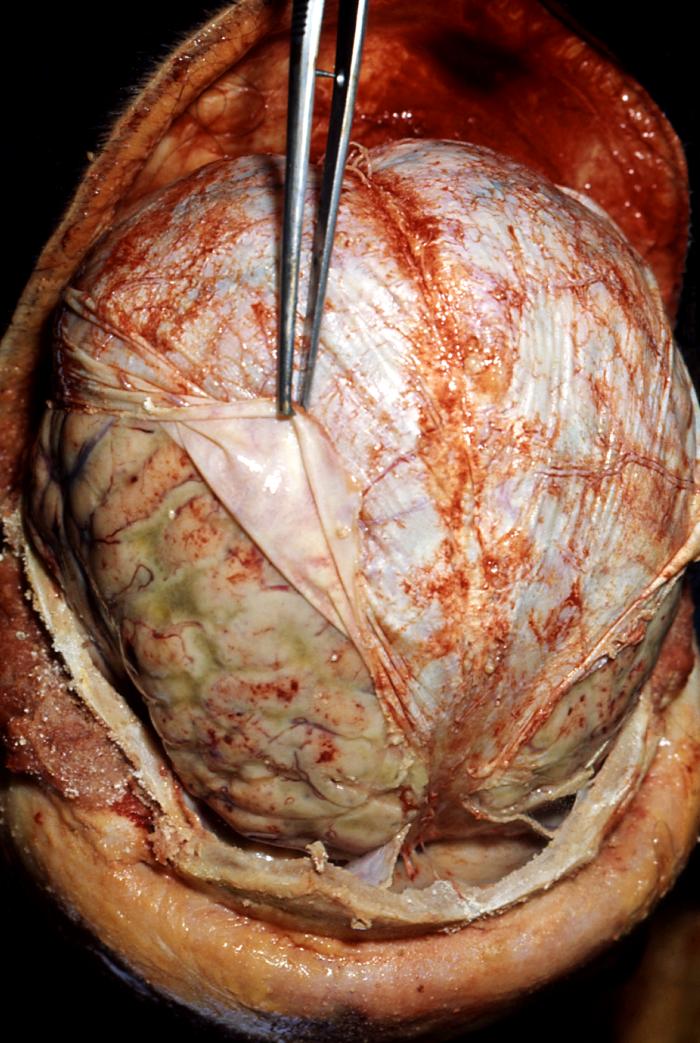Meningitis laboratory findings
|
Meningitis Main Page |
Editor-In-Chief: C. Michael Gibson, M.S., M.D. [1]; Associate Editor(s)-In-Chief: Cafer Zorkun, M.D., Ph.D. [2]
Laboratory Findings
Investigations include blood tests (electrolytes, liver and kidney function, inflammatory markers and a complete blood count) and usually X-ray examination of the chest. The most important test in identifying or ruling out meningitis is analysis of the cerebrospinal fluid (fluid that envelops the brain and the spinal cord) through lumbar puncture (LP). However, if the patient is at risk for a cerebral mass lesion or elevated intracranial pressure (recent head injury, a known immune system problem, localizing neurological signs, or evidence on examination of a raised ICP), a lumbar puncture may be contraindicated because of the possibility of fatal brain herniation. In such cases a CT or MRI scan is generally performed prior to the lumbar puncture to exclude this possibility. Otherwise, the CT or MRI should be performed after the LP, with MRI preferred over CT due to its superiority in demonstrating areas of cerebral edema, ischemia, and meningeal inflammation.
During the lumbar puncture procedure, the opening pressure is measured. A pressure of over 180 mmH2O is indicative of bacterial meningitis.
The CSF sample is examined for white blood cells (and which subtypes), red blood cells, protein content and glucose level. Gram staining of the sample may demonstrate bacteria in bacterial meningitis, but absence of bacteria does not exclude bacterial meningitis; microbiological culture of the sample may still yield a causative organism. The type of white blood cell predominantly present predicts whether meningitis is due to bacterial or viral infection. Other tests performed on the CSF sample include latex agglutination test, limulus lysates, or polymerase chain reaction (PCR) for bacterial or viral DNA. If the patient is immunocompromised, testing the CSF for toxoplasmosis, Epstein-Barr virus, cytomegalovirus, JC virus and fungal infection may be performed.

| Condition | Glucose | Protein | Cells |
|---|---|---|---|
| Acute bacterial meningitis | Low | high | high, often > 300/mm³ |
| Acute viral meningitis | Normal | normal or high | mononuclear, < 300/mm³ |
| Tuberculous meningitis | Low | high | pleocytosis, mixed < 300/mm³ |
| Fungal meningitis | Low | high | < 300/mm³ |
| Malignant meningitis | Low | high | usually mononuclear |
| Subarachnoid haemorrhage | Normal | normal, or high | Erythrocytes |
| Cerebrospinal Fluid | |||||
| Normal Levels | Acute Bacterial M. | Acute Viral M. | TB M. | Neuroborreliosis | |
| Cells/ul | < 5 | In the 1000s | In the 100s | In the 100s | Some 100 |
| Cells | Lymph:Monos 7:3 | Gran. > Lymph. | Lymph. > Gran. | Various leukos | Lymph. monocytic |
| Total Protein (mg/dl) | 45-60 | Typically 100-500 | Typically normal | Typically 100-200 | Typically up to 350 |
| Glucose Ratio (CSF/plasma) | Typically > 0.5 | < 0.3 | > 0.6 | < 0.5 | Normal |
| Lactate (mmol/l) | < 2.1 | > 2.1 | < 2.1 | > 2.1 | - |
| Others | ICP: 6-22 (cm H2O) | PCR of HSV-DNA | PCR of TBC-DNA | IgG/IgM CSF/Serum Ratio |
In bacterial meningitis, the CSF glucose to serum glucose ratio is < 0.4. The Gram stain is positive in >60% of cases, and culture in >80%. Latex agglutination may be positive in meningitis due to Streptococcus pneumoniae, Neisseria meningitidis, Haemophilus influenzae, Escherichia coli, Group B Streptococci. Limulus lysates may be positive in Gram-negative meningitis.
CSF Cultures
Cultures are often negative if CSF is taken after the administration of antibiotics. In these patients, PCR can be helpful in arriving at a diagnosis. It has been suggested that a CSF cortisol measurement may be helpful.[2]
Prediction Rules
The Bacterial Meningitis Score predicts reliably whether a child (older than two months) may have infectious meningitis. In children with at least 1 risk factor (positive CSF Gram stain, CSF absolute neutrophil count ≥ 1000 cell/µL, CSF protein ≥ 80 mg/dL, peripheral blood absolute neutrophil count ≥ 10,000 cell/µL, history of seizure before or at presentation time) it had a sensitivity of 100%, specificity of 63.5%, and negative predictive value of 100%.[3]
References
- ↑ Provan, Drew (2005). Oxford Handbook of clinical and laboratory investigation. Oxford: Oxford university press. ISBN 0198566638. Unknown parameter
|coauthors=ignored (help) - ↑ Holub M, Beran O, Dzupova O; et al. (2007). "Cortisol levels in cerebrospinal fluid correlate with severity and bacterial origin of meningitis". Critical Care. 11: R41. doi:10.1186/cc5729.
- ↑ Nigrovic LE, Kuppermann N, Macias CG; et al. (2007). "Clinical prediction rule for identifying children with cerebrospinal fluid pleocytosis at very low risk of bacterial meningitis". JAMA. 297 (1): 52–60. doi:10.1001/jama.297.1.52. PMID 17200475.